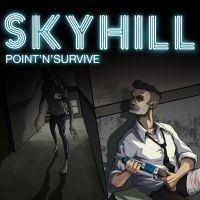Skyhill review – does another roguelike survival amuse or bore?
Skyhill’s biggest flaw is its lack of merits. It’s, technically speaking, a decently designed survival game, but neither its RPG elements nor the story nor the atmosphere are entertaining enough to keep the players engaged.
The review is based on the PC version.
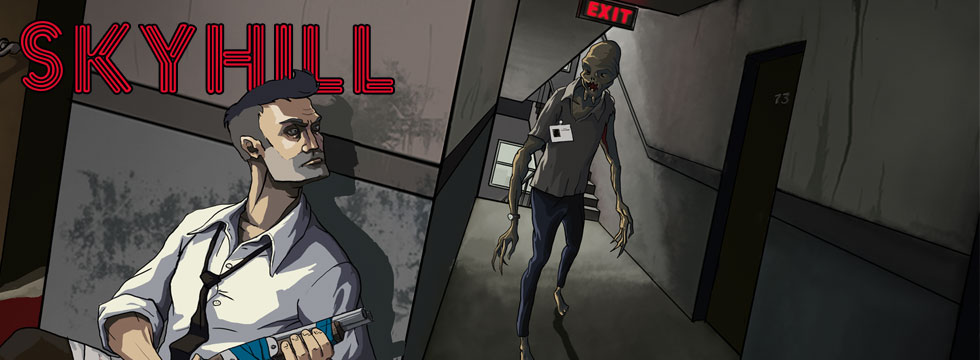
- amusing at first;
- looks nice;
- might work significantly better on mobiles;
- poses a nice challenge…
- …as long as you’re not using profits that murder the difficulty level;
- oversimplified combat and RPG elements;
- repetitive to the point of physical pain;
- negligible diversity of rooms and mutants;
- doesn’t stand out from the crowd.
Are you getting used to the post-apocalypse Fallout-style? Do you think that the End of Human Civilization means that you’re free to hunt for bandits and hide from mutated creatures in the ruins of a once-flourishing metropolis? Well, you can forget all of that now, because the only thing that awaited the protagonist of Skyhill at the disastrous end of World War III was a severe risk of developing arthritis. Why? It’s simple. From the sheer amount of stairs he has to climb and descend in the course of this game; not to mention the many occasions when he has to go through other people’s rooms and things.
Skyhill is Mandragora Team’s second game, the first one being Knitted Deer. We meet the protagonist just as he rents the best top-floor VIP suite in the titular Skyhill Hotel. His room choice offers many advantages but also some unexpected downsides – when the dreadful nuclear mushrooms begin to bloom on the horizon, he survives. Unfortunately, keeping himself that way may prove to be difficult, because nearly all the other guests and staff of Skyhill Hotel have turned into bloodthirsty beasts, and the shockwave from the nuclear explosion disabled the elevators. What was left for him was a long walk through the perilous corridors to scavenge for supplies, including constant trips back to his room to take some rest or create a new item – sometimes extending from the lower floors and all the way to the floor one hundred, where his safe haven awaits.
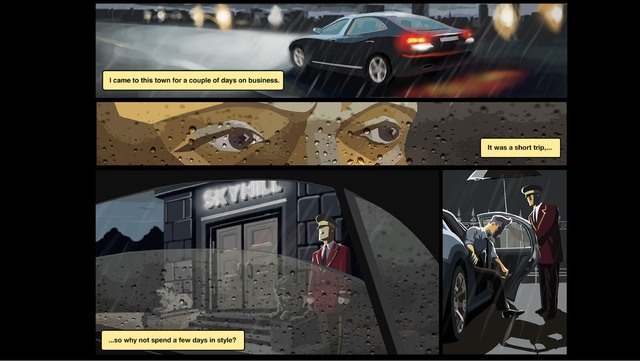
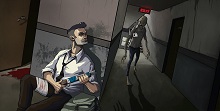
Except for Steam, Skyhill is also available on mobile devices, where - in small doses - it may work best – the game will be released for both iOS and Android. If you’d like to check if the game from Mandragora Team is worth the money, you can try the demo version and visit the first twenty floors of the building for free.
That’s the brief summary of the game. The creators offer us some pieces of plot along the way – in the press cuttings we can read about the global situation just before the end, we find some notes that reveal the fate of some other hotel guests, and the tape recordings talk of the protagonist himself – but the survival aspect is the main dish, one that dominates everything else. What makes it even worse is the fact that the creators are serious about the narrative. When I first heard of the game, I had a vision of a well-organized, self-absorbed businessman who had a sarcastic remark for every post-apocalyptic event he’d encounter, most of them pop-culture related. In reality, the story of Skyhill is as dead-serious as they come, while being nearly nonexistent and underexposed at the same time – no wonder it fails miserably when it comes to drawing attention.
Still, even the wasted comedy potential turns out to be unimportant, because everything else here is just an addition to the game’s survival elements. I admit, the guys from Mandragora know how to manage the main feature, but the fact that the game is simultaneously intended for mobile platforms has taken its toll. The room layout on every floor is identical (rooms on the left and right, the staircase and the sometimes functional elevator in the middle), and each of them has equal chance to grant us some more or less useful items. Good finds are, obviously, very rare – for the most part, you will be happy to see a band-aid or a half-rotten vegetable (eating it may satisfy your hunger, but you risk losing some health in the process), because many of the countless cabinets will yield you exactly nothing.
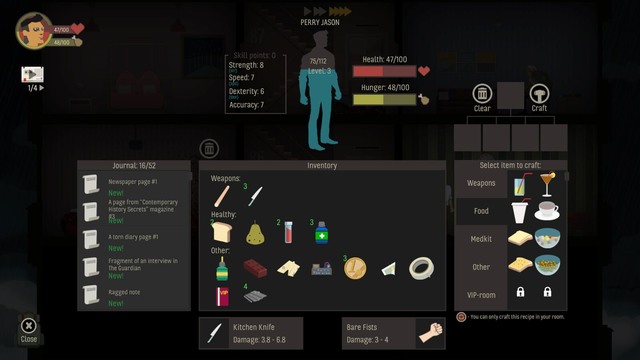
Crafting system lets us create five kinds of items: weapons, food, medical supplies, others (which can mean many things including a power generator, some cables or a roll of duct tape), and apartment additions. The apartment is the player’s home base and the key location in the Skyhill Hotel: this is where we sleep to regain our strength, tinker with things, and cook some more refined meals. The following things in our room can be upgraded: the kitchen (increases the number of available recipes), the bed (allows for a better rest), the workshop (increases the number of available weapons), and the room’s security measures, to make sure things, including us or our stuff, are safe when no one’s looking. With some creativity, we can build most things without resorting to super rare materials. That’s nice, because the upgrades are nearly indispensable to survive – without them we will be forced to wander the hotel feasting on dog food and fending off mutants with a simple kitchen knife until the game (or the protagonist) is done.
To be honest, the kitchen knife is not a bad choice, at the beginning at least. On the uppermost floors we encounter mostly common zombies or crazed hotel guests, but, when going further down, the difficulty increases. All fights are turn-based, and each turn we choose which body part of the enemy we want to attack – as usual, the most damaging attacks are the least likely to connect. The monsters, especially those we encounter on lower floors, are well-designed, and what remains of their clothes can be, in a way, charming – huge, ogre-like creature dressed in a cap and baseball jacket is an amusing sight. On the flip side, the diversity of monsters is significantly lacking, and when fighting them, you just repeat the same actions. Promptly, the combat quickly gets boring instead of thrilling and begins to irritatingly stand in the way of free exploration. Furthermore, the mutants rarely pose a significant challenge – enemies you cannot “outgun” can be easily “outrun”, as the game lets you flee from combat, and death (which means restarting the game from the beginning) in combat is mostly caused by unnecessary recklessness and/or taking one risk too many.
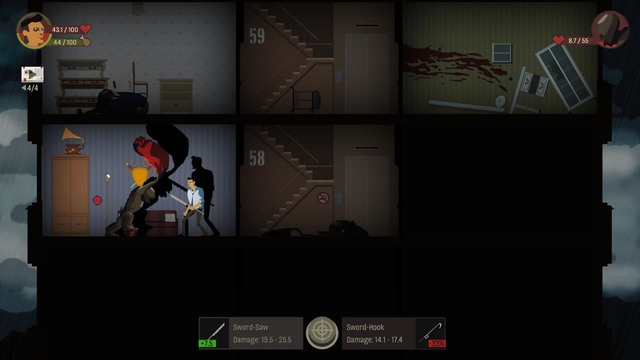
The truly dangerous enemies can be revisited when you gain a higher level and invest some stat points, as the creators have decided to add some RPG to the mix. It’s a nice inclusion, albeit a very simplistic one. A shame and a wasted opportunity as it could have been the thing that would separate the game from many other indie titles. We have four stats at our disposal: strength, speed, agility, and accuracy, which allow you to use better weapons, or add various bonuses to them, as well as increase our chance to dodge attacks, our critical hit ratio or weapon hit ratio in general. The game does not employ a perk system of any kind, and the stats have no impact on the most important factors: our health and hunger bars. We heal during sleep, but we can also use med kits and band-aids – there’s no problem in finding them. The hunger is our most deadly enemy – for most of the time we will be on the verge of starvation, scavenging the rooms in panic, hoping to find at least some slightly rotten fruits.
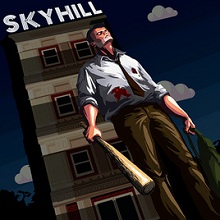
The game’s visuals have seen several redesigns since it was announced. Initial concept art suggested that Skyhill will look more like a comic, and the Health and Hunger bars were bigger and employed brighter colors at the time. Ultimately, the game features a minimalistic interface, which is a better match for the overall climate. Another interesting fact is that the initial promo materials showed three different characters; it seems only one of them made it this far.
Initially, Skyhill presents itself as a challenging but somewhat repetitive survival game. This outlook changes significantly after you beat the game for the first time – conquering subsequent floors unlocks profits, both active and passive, which the player can pick when beginning a new game. Unfortunately, the profits end up ruining the difficulty instead of tempering it – after choosing a single profit that allowed me to find more items I finished the game with enough food reserves to last for a week. The profits do have some negative repercussions, but they’re negligible in most cases: I’m going to lose one item every 10 turns. So what? In the meantime, I’ll find three rolls of duct tape, med kit, a food ration, and the Nazi gold train. In the long run, I decided not to choose any profit whatsoever. As a result, the next playthrough got boring somewhere around floor 70.
I think this may be the game’s true biggest fault. Randomly generated room layout and enemy placement does nothing to help the game’s variety in consecutive playthroughs, for the number of different available models and designs is very limited. From time to time, we are given small sub quests – usually in the form of messages found on cell phones - but none of them can escape the formula “go to floor X, kill the monster Y”, which we would have to do anyway at some point. To be honest, the best part remains the very beginning of the game, when we have almost nothing and every trash can be a lifesaver. However, as soon as we get some decent weapons and enough items to make something of our apartment, Skyhill becomes one of the best insomnia remedies known to mankind. Clearly, the game was designed not just “also” but “mainly” with mobile devices in mind, and it shows – longer gaming sessions are bound to be cut short by boredom.
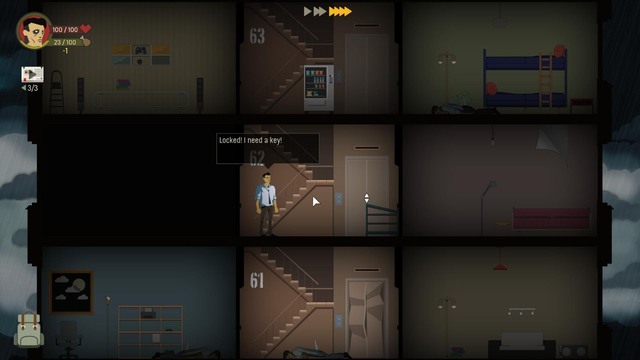
The designer’s focus can be seen in the visuals as well, although that’s not necessarily a bad thing – Skyhill looks quite good, while causing no trouble even for low-end PCs. All thanks to the somewhat unrealistic, cartoonish visual style, thick lines and moving shadows of which look very nice during combat. The music is not bad, but here also repetitiveness poses some problems – the tunes are short and may sound pleasant at first and fifth time you hear them, but definitely not on the twentieth…
It would be a lie to say that the Mandragora Team’s work bored me completely. The first two, three playthroughs were quite amusing, furthermore… actually no, that would be it. The game is perfect for mobiles, but on PC its charm doesn’t last for long. Overall, it’s oversimplified, doesn’t have the climate to hook the players on the mood alone, and it doesn’t have anything to set itself apart from competition. You see, indie gaming has been getting overcrowded lately, and a mix of roguelike and survival game with some RPG slapped on it doesn’t make Skyhill the hottest cake on the plate to say the least. Maybe a few years back it would have made a better impression, but now it has to be summed up as “passable but uninspired”.
Skyhill
Skyhill review – does another roguelike survival amuse or bore?
Skyhill’s biggest flaw is its lack of merits. It’s, technically speaking, a decently designed survival game, but neither its RPG elements nor the story nor the atmosphere are entertaining enough to keep the players engaged.
